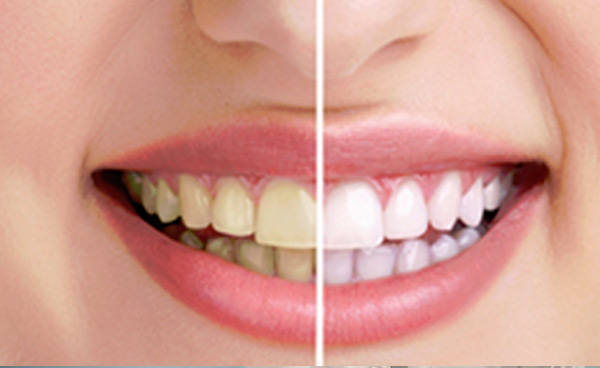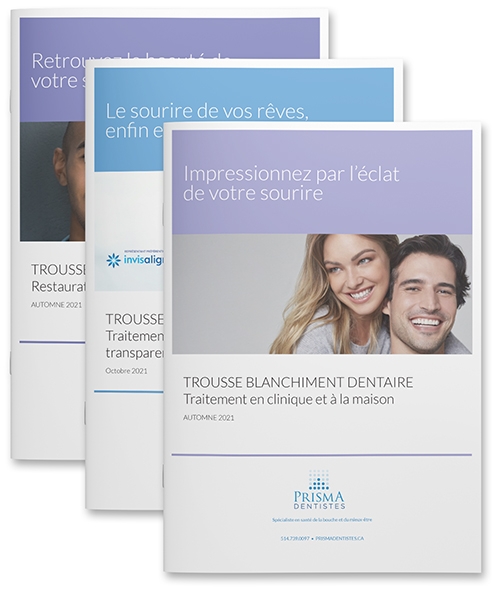Teeth whitening
Impress with a radiant smile
Although it affects many people, yellowing teeth often cause embarrassment. Yellow teeth are a common aesthetic concern. Fortunately, this situation can be countered with a tooth whitening treatment. Dr. Lechner in Montreal offers two solutions: treatment with customized trays, performed at home, and chairside whitening, performed in the clinic.
Teeth whitening: A radiant smile
There are many teeth whitening products and treatments available, many of them over-the-counter. However, for best and safest results, it’s best to opt for a professional solution, such as those offered by your Town of Mount Royal dentists. Professional teeth whitening can be performed in a clinic or at home. Either way, it’s an effective solution to help you regain your radiant smile!
Overview of teeth whitening
Your teeth are not naturally white and their colour may even vary from grayish to yellow, in addition to darkening with age. Using tobacco, taking certain medications and consuming foods that stain (such as coffee, tea, red wine, dark chocolate, spices, etc.) can exacerbate this colouration, as these products can lodge in the teeth’s enamel and dentin. Only teeth whitening in a clinic can act on this encrusted colouring, as the whitening products available in pharmacies act only on the surface stains.
The first rule of successful whitening follows a formula advocated by many professionals: the white of your teeth should match the whites of your eyes. If there’s a big contrast between the two, your teeth will look dull. By reducing this contrast, bleaching excels at restoring a dazzling smile.
In-clinic teeth whitening is formulated to work deeply and in the safest way possible, without endangering your dental health in general. Your Prisma dentist uses gels available only to professional clinicians, since these products have a higher concentration of whitening agent, combined with a high water content to ensure their safety and to keep your teeth hydrated. The custom-made mouthguard also helps ensure that the entire surface of your teeth will be whitened evenly.
IMPORTANT
Do you suffer from receding gums, meaning that your gums have shrunk and exposed the base of your teeth, which may or may not have turned brown over time? It is important to note that any exposed part of your teeth does not benefit from natural enamel coverage, so whitening agents CANNOT ACT on its colour. To prevent having a two-tone smile and to achieve a uniform, white result, ask Dr Lechner for advice. Periodontal surgery to reposition the gum tissue or a light filling may be suggested depending on the circumstances.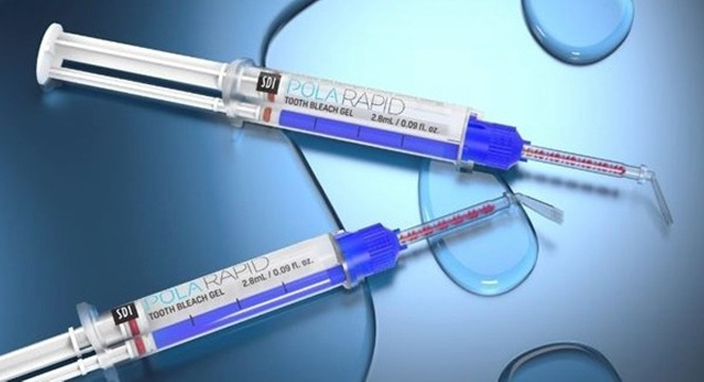
The most frequently asked questions about teeth whitening
Teeth vary from person to person, so they discolour, take colour or stain for just as varied reasons. For some people, a change in the shade of their natural teeth occurs because of the foods that they consume, like coffee, tea, dark chocolate, herbal tea, red wine or spices such as curry, turmeric, etc. Smoking also causes changes to the colour of your teeth. Some medications that contain tetracycline, such as antibiotics and acne treatments, can also cause the teeth to stain. Lastly, taking too much fluoride at a young age and cavities can also cause your teeth to stain.
In the clinic, your Prisma dentist applies a whitening product to your teeth. It then breaks down into water and oxygen ions. Generally speaking, the ions will penetrate your teeth’s enamel and attack the molecules responsible for the stains and discolouration, to break them down and make them colourless. The result will be a more intense white depending on the number of ions and how long they were active/present on your teeth.
Most online teeth whitening systems use sodium bicarbonate or mild abrasives as their active whitening ingredients. Their role is limited to treating and removing light superficial stains. Unlike professional gels used only in dental clinics, they are not formulated to penetrate tooth enamel and break down large or encrusted stains.
It usually takes 45 minutes to 1 hour for the assessment, impression-taking for the mouthguard and the whitening itself, followed by an at-home treatment that varies between 5 and 14 days to optimize the results. It is also possible to perform 2 treatments in the clinic if you don’t wish to perform the whitening at home. The cost of 2 clinical treatments is, however, higher than the “clinic treatment + home treatment” combination.
The duration of effectiveness varies from person to person, depending on both oral hygiene (brushing, flossing and regular cleaning at the dentist) and your consumption habits (food, drinks, tobacco, etc.). In other words, the reasons that initially caused your teeth to stain are the same ones that will impact how long the whitening lasts, if you don’t change your habits. Generally, you should enjoy a maximum brilliance of 1 to 2 years, which will gradually fade over 2 to 4 years without any in-clinic or at-home touch-up.
If you have restorations (fillings), crowns or veneers, whitening can remove stains without affecting the repair’s original colour.
There are certain side effects which vary from patient to patient. If you follow your Prisma dentist’s directions for using the whitening products given to you, you should experience no significant side effects. However, some more sensitive people may experience a temporary sensitivity to heat or cold, ranging from mild to acute, which should go away within a few hours after treatment. No long-term sensitivity is to be expected.
It is also possible to shorten or space out the duration home treatment applications. Your dentist may also use or recommend a desensitizing agent at the same time. Following the 2-2-2 rule (discussed in Maintaining your smile) should also reduce any risk of acute sensitization. Finally, during the treatments, it is recommended to avoid citrus-flavoured carbonated drinks to prevent tooth sensitivity.
As long-term clinical studies have not been performed on this subject, teeth whitening products are not recommended during pregnancy.
Treatment steps
Please note: An Informed Consent Form must be signed before beginning any dental treatment.
1st step: Complete the form
An evaluation and quality control form is completed at the beginning and at the end of treatment. Its purpose is to collect both your medical and dental information as well as an overview of your lifestyle, which could have an impact on whitening and the treatment steps to be followed. This form will also enable you to assess your level of satisfaction with the final outcome and to guide future whitening treatments, among other things.
In-clinic whitening steps
You’ve never had whitening done in a dental clinic and you’re wondering how everything goes? Here’s an overview of the 12 typical steps that take in total about 45 minutes to an hour.
- The dental technician will determine and record the preoperative shade of your teeth, using the corresponding shade.
- If necessary, your teeth will be cleaned with a pumice stone to prepare them.
- An impression of your teeth will be taken to make a custom mouthpiece for use in at-home whitening.
- The technician will place retractors in your mouth and smear petroleum jelly on any part of your lips that remains exposed.
- Your teeth will be dried and a gum barrier (made of a soft, comfortable resin that is resistant to hydrogen peroxide) will be applied between the teeth and the gums above and below to protect them.
- The gum barrier is light-cured, that is, it is heat-hardened using a small device that the technician sweeps inside the mouth for as little as 10 to 20 seconds.
- A thin layer of gel will be applied directly to all the teeth to be treated, using a small applicator.
- Now is the time to be patient! The gel should then act for 8 minutes.
- The technician will aspirate the gel using a suction device similar to the one used in many other dental treatments.
- The technician will repeat Steps 7 to 9 at least 3 times, or even 4 if necessary, to achieve the desired whiteness.
- When the last application is complete, all of the gel will be aspirated and removed. After asking you to rinse, the technician will perform a final vacuum and rinse.
- There you go! The technician will save the final shade (photo) for your file, as a reminder for the future.
At-home whitening steps
For optimal whiteness, your Prisma dentist will then recommend additional at-home whitening. To do this, they will give you POLA brand whitening gel in two different formulations, POLA Day and POLA Night. Both are designed using photodynamic therapy (PDT) technology, an innovation that helps prevent tooth sensitivity during and after application.
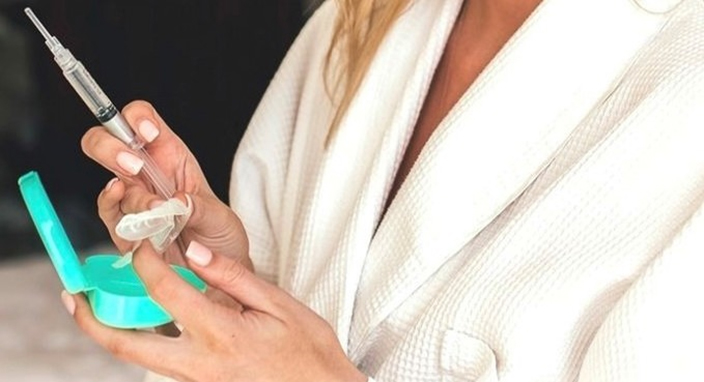
It is important to use POLA products at the scheduled time of day and night, since their whitening agent and concentration are suitable for the recommended duration. During the day, hydrogen peroxide is used for whitening, as it is more intense and efficient. At night, for a slower, more gentler action, the gel instead contains carbamide peroxide. POLA Night can also be used during the day for people who already suffer from tooth sensitivity, so talk about it with your Prisma dentist.
As a comparison:
1% hydrogen peroxide = approximately 3% carbamide peroxide
At-home treatment formulations
| Pola Day (1 formulation) | Pola Night (2 formulations to choose from) |
| With 9.5% hydrogen peroxide | With 16% carbamide peroxide |
| (or) With 22% carbamide peroxide |
Duration of at-home application
| DAYTIME: Pola Day | NIGHTTIME: Pola Night |
| 2 x 15 minutes per day | If using the 16% gel: From 90 minutes to overnight (about 8 hours) |
| (or) 1 x 30 minutes per day | If using the 22% gel: 1 x for 45 minutes to a maximum of 2 hours per day |

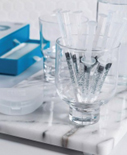
At-home application steps
- Put a small drop of gel into each compartment of the mouthguard.
- Place the mouthguard with the gel onto your teeth.
- If you apply too much gel, remove any excess gel in your mouth with a soft, dry toothbrush or tissue.
- Wait for xxx.
- Remove the mouthguard. Rinse the mouthguard and your mouth with lukewarm water.
- Brush your teeth with one of the recommended toothpastes for sensitive teeth (see the Maintaining your smile section).
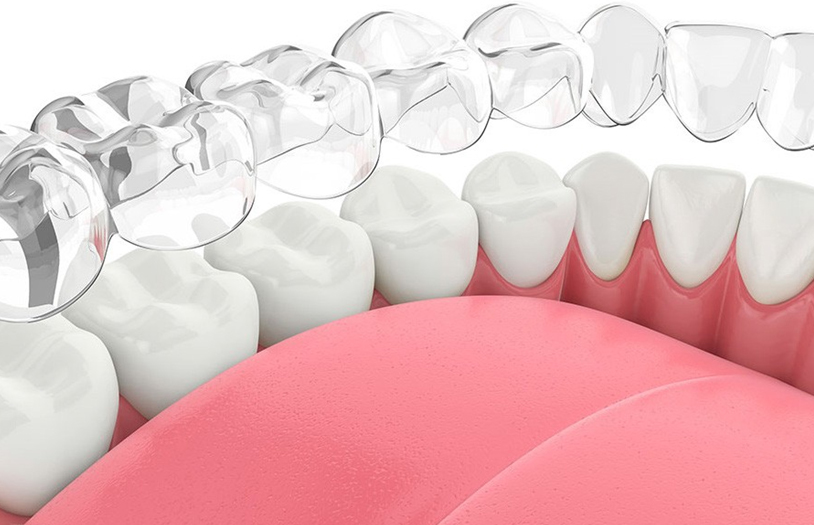
Advantages and disadvantages
Advantages of whitening
Beyond the aesthetic and psychological benefits associated with a radiant, white smile, there are many advantages of performing dental whitening in a clinic. Since the treatment is preceded by an evaluation by your dentist, any risk or contraindication related to your dental health will be identified and your dentist can advise you on the best care for you. If you are a good candidate, in-clinic whitening provides for faster progression of several shades in a single visit.
Disadvantages of whitening
Some patients may develop tooth sensitivity during treatment, upon contact with heat or cold. Using a desensitizing toothpaste will usually remedy the issue. Although the mouthguard is custom made, sensitivity to the gums and soft tissues (cheeks, mucous membranes) may occur if the fit is not optimal. This inconvenience can be exacerbated if you do not follow the directions and apply too much gel in the mouthguard. Avoid swallowing the excess product, to prevent irritation to the throat. Lastly, wearing a mouthguard prevents perfect occlusion during the treatment itself, which may cause joint discomfort. The sensation should wear off once the application is complete and the mouthguard is removed.
When teeth whitening at home, regardless of the nature of the discomfort, it is recommended to temporarily suspend the treatment and consult your Prisma dentist.
Before and after photos
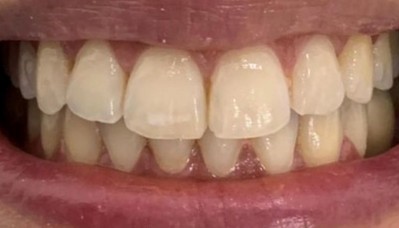

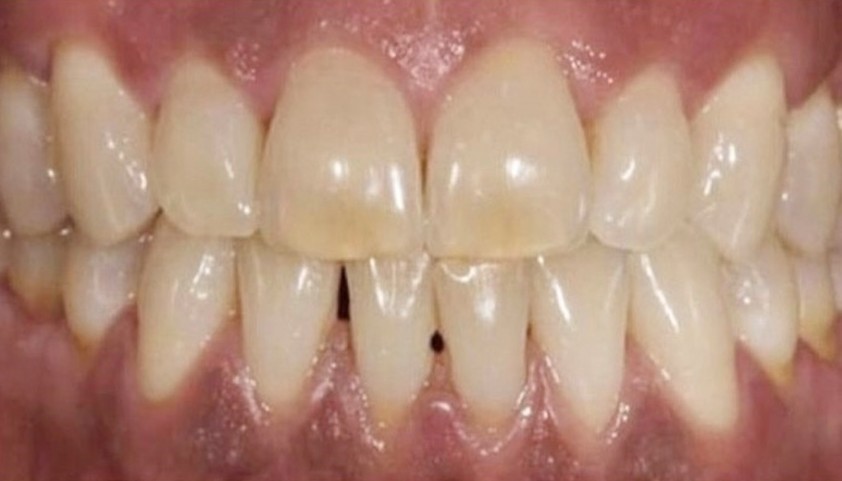

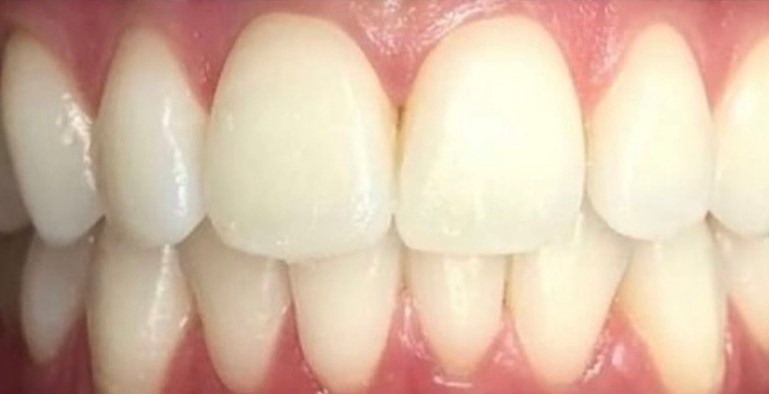
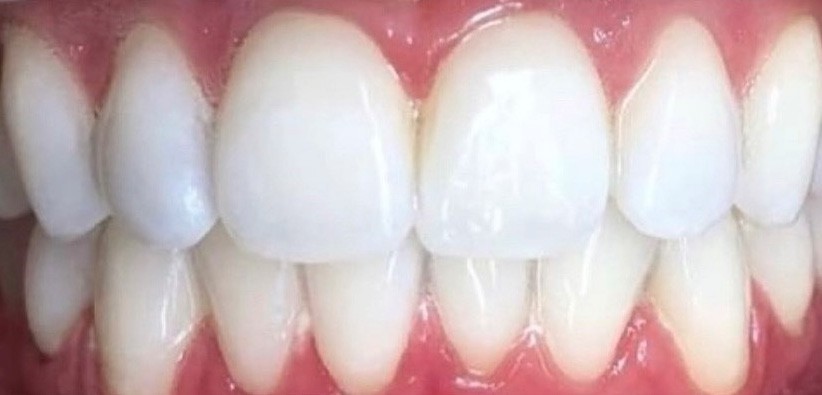
Maintaining your smile
To ensure the success of your whitening treatment and to help prevent tooth sensitivity, your role is essential. You must adopt and follow your Prisma dentist’s oral hygiene advice, summarized here as a reminder.
Toothpaste with potassium nitrate
Before, during and after whitening treatments in clinic and at home, you should use a potassium nitrate-based desensitizing toothpaste. This type of toothpaste protects and soothes by desensitizing the nerve endings inside the teeth (called “dentin” or “dental pulp”). Relief only begins to take effect two weeks after switching to sensitive toothpaste, so begin using it 14 days before your scheduled clinic whitening date.
The effect of potassium nitrate strengthens over time if you brush your teeth twice a day, every day. Potassium ions accumulate in the dental pulp and make the nerve insensitive to stimuli such as ice water, hot coffee, winter air, etc. This is why using toothpaste with potassium nitrate is recommended long-term for people with dental hypersensitivity. Here are a few types you can choose from:
- Colgate for sensitive teeth
- Sensodyne REGULAR
- Sensodyne Pro Enamel
- PreviDent 5000 for sensitive teeth
- Crest Sensitive or Crest Sensi-Relief
The 2-2-2 rule
For a successful whitening treatment, there is an easy-to-remember 2-2-2 rule that you must follow. You should brush your teeth with desensitizing toothpaste as follows:
2 weeks before the beginning of treatment
2 times per day
2 minutes for each brushing
Important: With each brushing, you should spit, but do not rinse, drink or eat for the next 30 minutes.
To prevent tooth sensitivity, it is even recommended to follow this rule until the end of the whitening treatment. This will prevent you from forgetting to skip an application during the at-home treatment and hindering your ability to achieve optimal results.
Recommended maintenance steps
BEFORE in-clinic whitening
Follow the 2-2-2 rule to prepare for dental whitening in the clinic.
DURING at-home whitening
Do not consume very colourful foods, drinks or spices such as coffee, tea, red wine, tomato sauce, soy sauce, beets, curry, mustard, chocolate, etc. within 48 hours of application, as the pores of the enamel are open and any pigment embedded in it may be impossible to dislodge.
AFTER whitening
You can resume brushing your teeth with your usual toothpaste immediately after the last in-clinic or at-home application. On the other hand, you must wait 48 hours before resuming your eating habits.
Other recommended dental treatments
As we have seen, your Prisma dentist could recommend preliminary, parallel or complementary treatments in order to obtain a smile of harmonious whiteness.
If you are suffering from a receding gumline, meaning your gums have shrunk and exposed the base of your teeth, treatments such as periodontal surgery to reposition the gum tissue or a light filling may be suggested. This is because, as noted above, any exposed part of your teeth does not benefit from natural enamel coverage, so whitening agents CANNOT ACT on their colour. To prevent having a two- tone smile and to obtain a uniform white result, ask your Prisma dentist for advice.
Your dentist may suggest tooth whitening before crowning or veneering to match the material to the new shade of your teeth. Whitening may also be recommended if you want to realign your teeth, using Invisalign orthodontic technology, for example, to achieve the smile of your dreams. Lastly, If you are getting cosmetic repairs on worn teeth in the front and you plan to have all your teeth whitened, pre- repair bleaching would be advisable to ensure, once again, the most harmonious and integrated result possible.



